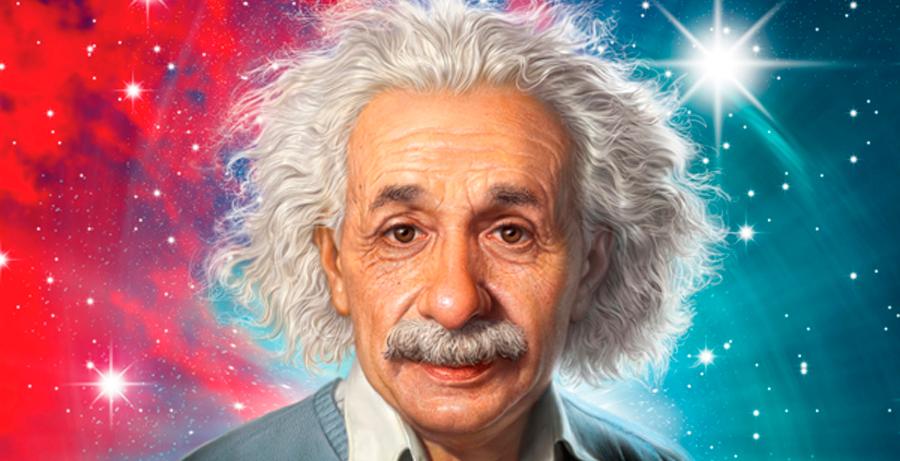Albert Einstein: The Father Of Modern Physics

Albert Einstein was one of the pioneers of the physics world in the 20th century, who changed the way how people perceived physics by escalating it to a whole new level. The German-born physicist – who looked as if he had lost his comb while he was busy with one of his works – was a not so brilliant child at school. We have read stories about Einstein being a subject of criticism at school which were a consequence of his slow learning abilities.
Albert Einstein’s father moved his family to Italy after the company he created with his brother ran into losses. Young Einstein was left at their relative’s boarding house to attend his school at Luitpold Gymnasium in Munich but he tried all the different gimmicks to skip the school. So, his family shifted him to Italy. He later got admission in the government-owned Eidgenössische Polytechnische Schule (Swiss Federal Polytechnic School) in Zurich, Switzerland.
No one would have thought, this slow-talking kid would one day become one of the most influential and famous people in the world and would be offered to become the president of Israel, for which he declined politely. Einstein’s contribution to the Modern Physics gave him the title of the Father Of Modern Physics. The theoretical physicist worked on Quantum Mechanics, he developed the Theory of Relativity and predicted about Gravitational Waves which were a part of the vast portfolio of his research work, more than 300 research papers were published by him.
Einstein’s first major research paper, “The Investigation of the State of Aether in Magnetic Fields” was inspired by a children’s science textbook given to him by Max Talmud – A polish medical student who was a frequent visitor to the Einstein family and became his tutor.
As time passed, Einstein’s interest in Physics increased manifold which turned him into a research paper publishing machine. He made many visits to the United States when he was invited all around the world for guest lectures. During the early 20th century, Germany saw the rise of Adolf Hitler and the Nazis, and being a Jewish, Einstein faced death threats which motivated him to move to the United States. After all, who would like to stay in the country where your cottage gets turned into a Hitler Youth camp and a German magazine phrases you as “not yet hanged”.
His work was a prime inclusion in the book burning act by the Nazis. “I must confess that the degree of their brutality and cowardice came as something of a surprise”, he wrote in a letter to his friend and physicist Max Born, who also had shifted from Germany to England due to the same reasons. In October 1933, he started working at the Institute of Advanced Science in Princeton after fleeing from Germany, where he was a Professor at Berlin Academy of Sciences. He was later granted an American citizenship in 1940.
Albert Einstein continued his immigrant life in the US until his death in 1955. The cause of his death was abdominal aortic aneurysm but it was more of a self-decision as he refused to go for surgery. “I want to go when I want. It is tasteless to prolong life artificially. I have done my share, it is time to go. I will do it elegantly.” he stated at that time.
After his death, his brain was removed by Dr. Harvey during the autopsy process and kept for 20 years in a jar. It was revealed that he did it for the purpose of research. His brain was definitely better than others having a partial lobe 15% larger than the normal human brain. Einstein’s eyeballs – which are now safely resting in a safe box in NYC – were also removed by Harvey which he handed over to Einstein’s eye doctor, Henry Abrams. “Albert Einstein was a very important part of my life. A lasting influence. Having his eyes means the professor’s life has not ended. A part of him is still with me.” – Abrams said in an interview. “He’s not dead … because I have his eyes.”
Let us have a look at some of the greatest works of Albert Einstein:
The E=MC^2 (Mass-Energy Equivalence) Equation:
This equation made a considerable dent to the earlier belief that mass and energy were two different and completely unrelated entities. The idea of Mass-Energy equivalence first appeared in Einstein’s paper “Does the Inertia of a Body Depend Upon Its Energy Content?” in 1905 which was originally written as m=L/c^2 (L is for Lagrangian which denotes the general form of energy) but he later modified it to a simpler form E=mc^2. In the equation, E represents energy, c represents the speed of light in the vacuum which is 3*10^8 m/s or 186,282 miles per second, and m is for mass.
The equation throws light on how much energy is stored in a given mass. A tremendous amount of energy could be harnessed from a single particle as its mass is multiplied by the square of the speed of light i.e. (3*10^8)^2 m/s, which amounts to a huge magnitude of energy for a small particle. So, if you’re an 80-kilo person, enough energy could be generated to power approximately 10 million homes for more than 150 years. You should tap your back on that note. The fundamentals of this equation propelled the development of massive human massacre things to benefit the malevolent intentions of the human society, like the atomic bomb attacks on Hiroshima and Nagasaki in Japan. The bombings led to a widespread human destruction to the extent that it altered the gene structure of the future generations.
Photoelectric Effect:
In this effect, when packets of light (photons) of frequency greater than the threshold frequency (below which no electrons are emitted from the surface) for a given metal are incident on its surface, electrons are smashed off from the surface. Thus, an amount of current is generated on the metal surface. These electrons can be termed as Photoelectrons. In 1921, Einstein got a Nobel Prize for discovering the photoelectric effect for which he had published a research paper in 1905.
The Photoelectric Effect was later demonstrated by Robert Millikan who was also awarded Nobel Prize in 1923. The effect has its natural application in the form of “moondust” which is an “atmosphere of dust” created above moon’s surface due its particle being charged by the falling sunlight and getting lifted up – several kilometres high in case of lighter particles – due to electrostatic levitation. A similar phenomenon is known as Magnetic Levitation – in which Magnetic fields are used to suspend objects in air – could be used to propel Maglev trains at theoretical speeds up to 8000 km per hour inside a vacuum tunnel.
Wave-Particle Duality:
A confusion about the nature of light was prevalent when various scientists around the world were busy with the development of concepts which were a part of what we call, the quantum physics. It wasn’t clear, whether light exhibits particle or wave nature. Einstein’s Wave-Particle Duality concept was like a water well in a barren land. His theory was inspired by the experiments conducted by Thomas Young – demonstrated the wave nature of light through his double slit experiment – and Max Planck – found exhibited particle if the light was emitted in small bursts rather than as a continuous wave. According to Einstein, the photoelectric effect could only come into action if the light was incident on a surface in small portions or photons (called later on). If one would consider the wave nature of light for the purpose of photoelectric effect, the calculations won’t be efficient enough to prove its existence.
Theory of Relativity:
This theory has two versions, known as Special relativity (1905) and General relativity (1915). These involve some hard to grasp physics concepts which are enough to burn your brain circuits if you try to get the hang of them. Albert Einstein conceptualised space and time as part of a continuum and could be visualized as a fabric sheet. In the theory of special relativity, Einstein showed that speed of light was irrespective of the speed and direction of the observer. That was contradictory to the pre-existent concept in which speed of an object varied according to the speed and direction of the observer, like if someone is running towards you from the front side seems faster than you are running after a person. The theory also emphasised that time is slower for a person moving at high speeds. You might’ve heard about the Twin Paradox, in which one twin is sent into space in a spaceship travelling at very high speeds, when he will return to the earth after several years he will be younger than his brother who was living on the earth. Now, that’s what you call a short circuit, isn’t it? You might want to a check if smoke is coming out of your head.
The general relativity helped in finding the origins of the gravitational force – proposed by Isaac Newton after an apple fell on his head but he was never able to tell where the force came from – by visualizing the space-time continuum along a body. If you place a heavy ball on the center of rubber sheet it would create a dimple in it. Thus, another ball placed on the edge of the rubber sheet would roll down towards the ball at the center. Similar phenomena make rocks and other objects attracted towards planets.
Einstein Beyond Physics:
Albert Einstein was a renowned name in the physics community and he was voted as the best physicist ever in 1999. Apart from being a celebrity scientist, his name and picture were featured in various writings and other forms of media. Although, it is mandatory to obtain a license to use Einstein’s name and photo for commercial purposes.
Einstein’s personality has been widely adopted for the purpose of depicting mad and absent-minded scientists. He was a motivation behind many of the Hollywood movie characters like the Star Wars fame Yoda, whose eyes were modeled after Einstein. The Autobot Que in the movie Transformers: Dark of The Moon, had a character sketch similar to that of Einstein with high intellectual level and facial design resembling Einstein’s moustache, eyes, and wild hair. The music industry has been his big fan, American singer Bob Dylan paid a tribute to the physicist in his song “Desolation Row”.
Einstein also developed an interest in violin during his childhood which continued throughout his life. He was a self-taught violinist who could come up with soothing melodies without “ever practicing systematically”, he said. He often shared the stage with professional violinists while playing chamber music upfront a familiar audience but never considered pursuing it as a career.
Politically, Albert Einstein was inclined towards Socialism. His opinions often acted as a deciding judgment concerning to the matters unrelated to physics. His religious beliefs were contradictory as per the assumptions made by authors like Richard Dawkins. According to John Marsh who wrote for bethinking, Dawkins misunderstood Einstein’s religious belief to be of an atheist when he referred his quotes recorded in Max Jammer’s book and that “if any intellectual high treason has been committed, it has been committed by Dawkins himself, who has failed to deal carefully with what Einstein actually said, thereby confusing two very different understandings of God.” In his well-critiqued article, Marsh tried to come up with what could be the true religious beliefs of Albert Einstein. Einstein criticized having a personal god but he did acknowledge that a superpower – unconnected to this world – does exist which has created the universe and the laws of science governing it.
The modern media has very few of Einstein’s personal interview archives but many simulated versions have been created using the quotes and records of his written work. A similar interview published by ScienceMag was created out of a writing made by Alice Calaprice from the Princeton University Press. “In 1996, she published a volume entitled The Quotable Einstein, a comprehensive, meticulously referenced, annotated, and carefully arranged compilation of Einstein’s quotes. For 2011, Calaprice has enlarged this to The Ultimate Quotable Einstein, a nearly 600-page volume of approximately 1600 quotations” – writes Dalbert for Sciencemag.org.
The Q&A interview tries to elaborate Albert Einstein’s beliefs on various aspects of science. “Science is the attempt to make the chaotic diversity of our sense-experience correspond to a logically uniform system of thought. In this system, single experiences must be correlated with the theoretic structure in such a way that the resulting coordination is unique and convincing. . . . The sense experiences are the given subject matter, but the theory that shall interpret them is man-made. It is . . . hypothetical, never completely final, always subject to question and doubt.” – the simulated Einstein replied to a question.
I have tried to cover as much as I could about the life of this great person but his priceless contribution to the mankind is beyond the scope of this writing. Anna Vital, an information designer made a beautiful attempt to sum up Einstein’s life in an infographic.
You’ll find these interesting:






